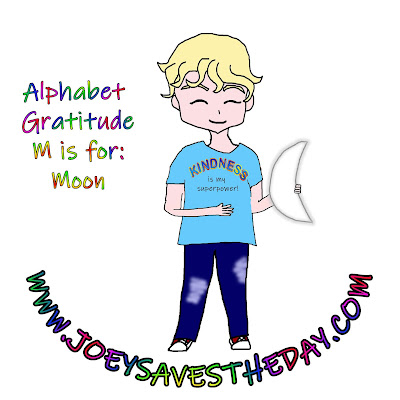Facts About the Moon
We are on the letter Mm of the gratitude alphabet! M is for
Moon.
WHAT ARE YOU THANKFUL THAT BEGINS WITH THE LETTER M?
I am thankful for the Moon! The gravitational forces between the Earth, the moon, and the sun combine to create the phenomenon known as tides in the ocean. The gravitational pull of the moon is the primary driver of these tides. As the moon orbits the Earth, its gravitational force causes the water in the oceans to bulge out towards it, creating high tides. At the same time, on the opposite side of the Earth, another high tide is formed due to the centrifugal force. This interaction results in the rhythmic rise and fall of the ocean's surface, known as high and low tides.
Facts about the Moon:
1. The gravitational force of the Earth, which is the result of its mass, holds the moon in a stable orbit around it. This force keeps the moon from drifting away into space and is responsible for the celestial body's consistent position relative to the Earth.
2. When observing the moon, one can discern that its surface is characterized by a mottled appearance, featuring both light and dark areas. The dark regions, known as Maria (Latin for seas), are relatively young plains comprised of solidified lava. In contrast, the light areas consist of mountainous terrain known as Highlands.
3. The Moon, Earth’s only natural satellite, is a celestial body that orbits around our planet. Classified as a natural satellite, the Moon revolves around the Earth, taking approximately one month to complete a full orbit. As the Moon orbits the Earth, our planet simultaneously orbits the Sun. It's important to note that the Moon is categorized as a satellite object rather than a planet.
4. Lunar water, also known as ice, has been discovered on the moon.
5. Moonquakes are seismic activities that occur on the moon, resembling earthquakes on Earth. However, moonquakes are generally not as intense as earthquakes. They can last up to 2 minutes or sometimes even longer. These moonquakes provide valuable insights into the geological characteristics and processes taking place on the moon.
6. On the moon, a single day lasts approximately 29 Earth days.
7. The moon does not have distinct periods of changing weather and temperature like Earth does, which we call seasons.
8. Lunar dust, also known as moon dust, is made up of fine particles of various silicate materials, including rock and mineral fragments, on the moon's surface. It is formed by micrometeorite impacts, volcanic activity, and the breakdown of surface rocks by solar wind and cosmic rays. Due to the absence of weathering and erosion processes, lunar dust retains its sharp, angular shape and can pose challenges for human exploration and equipment maintenance during lunar missions.
Can you share a fact about the moon with us?
Books about the moon:
1. I Am the Moon: by Rebecca McDonald
2. Moon! Earth's Best Friend by Stacy McAnulty
3. So That's How the Moon Changes Shape! by Allan Fowler
4. What is the Moon? by Katie Daynes
Parents make sure books are child-friendly before reading them to their/children.
Get your moon coloring worksheet by clicking here:








No comments:
Post a Comment